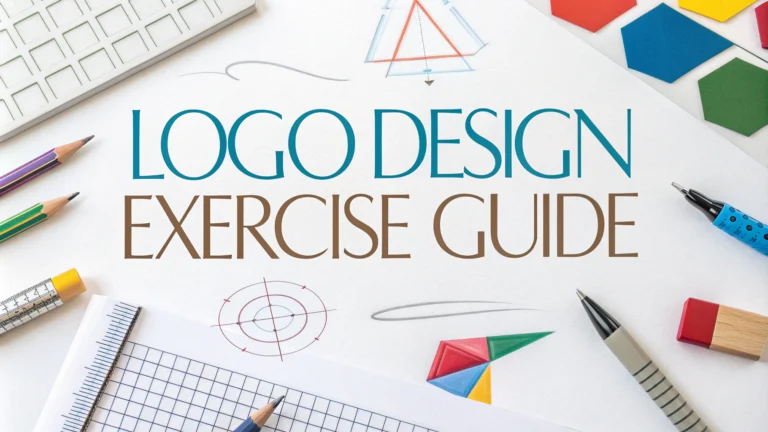Logo design combines artistic skill and strategic thinking to create visual identifiers that represent brands effectively.
Planning Your Logo Design
Research your client’s industry, competitors, and target audience before starting any design work.
Write down key brand attributes and values that the logo should communicate.
- Brand personality traits
- Target audience demographics
- Industry positioning
- Color psychology preferences
Essential Design Elements
Select fonts that match your brand’s character – serif fonts convey tradition while sans-serif suggests modernity.
Choose colors strategically using color psychology: red for energy, blue for trust, green for growth.
| Logo Type | Best Used For |
|---|---|
| Wordmark | Companies with distinct names |
| Symbol | International brands |
| Combination mark | Maximum versatility |
Technical Requirements
Create your logo in vector format using Adobe Illustrator or similar software for scalability.
- Save in multiple formats (AI, EPS, PDF, PNG, JPG)
- Test at different sizes (favicon to billboard)
- Check legibility in black and white
- Ensure it works on light and dark backgrounds
Common Mistakes to Avoid
Avoid using too many colors – stick to 2-3 maximum for better recognition.
Skip trendy effects that might date quickly, like gradients or complex shadows.
Never use stock icons or clip art in professional logo design.
Recommended Tools
- Professional: Adobe Illustrator ($20.99/month)
- Budget-friendly: Affinity Designer ($54.99 one-time)
- Free option: Inkscape
Logo File Delivery
Provide clients with a complete package including:
- Vector source files (AI, EPS)
- Web-ready formats (PNG, JPG)
- Style guide with color codes
- Usage guidelines document
Test final designs across multiple platforms and mediums before delivering to clients.
Include clear usage instructions and brand guidelines with the final deliverables.
Design Process Best Practices
Start with rough sketches on paper before moving to digital tools.
Create multiple concept variations to present diverse options to clients.
- Develop 3-5 distinct concepts
- Present black and white versions first
- Document your design rationale
- Allow for 2-3 revision rounds
Version Control
Maintain organized files throughout the design process for efficient revisions.
- Name files systematically
- Keep all iterations archived
- Track client feedback
- Document approval stages
Logo Usage Guidelines
Spacing Requirements
Define clear spacing rules around the logo to maintain visual impact.
Size Restrictions
Specify minimum size requirements for various applications.
Conclusion
Successful logo design requires careful planning, technical expertise, and attention to brand strategy. Follow established guidelines while maintaining creative innovation to create lasting brand identifiers.
Remember that effective logos are simple, memorable, and versatile across all applications. Focus on timeless design principles rather than temporary trends.
- Document all design decisions
- Maintain professional standards
- Deliver complete, organized files
- Provide clear usage instructions
FAQs
- How long does a professional logo design process typically take?
A professional logo design process typically takes 2-4 weeks, including research, conceptualization, initial designs, revisions, and finalization. Complex projects may take longer. - What are the essential elements of an effective logo design?
The essential elements include simplicity, memorability, scalability, versatility, relevance to the brand, and appropriate use of color, typography, and symbolism. - How much should I expect to pay for a professional logo design?
Professional logo design costs range from $300 to $2500+ for small businesses, while enterprise-level branding can cost $10,000+. Pricing varies based on designer experience, complexity, and deliverables. - What file formats should I receive with my final logo design?
You should receive vector files (AI, EPS, SVG), raster files (JPEG, PNG), and various color versions (CMYK for print, RGB for digital, black and white variations). - Should my logo work in black and white?
Yes, a well-designed logo must work effectively in black and white, as it ensures versatility for various applications, faxes, embroidery, and single-color printing. - What’s the difference between raster and vector logo files?
Vector files are scalable without quality loss and are ideal for printing at any size, while raster files are pixel-based and lose quality when enlarged. - How many logo concepts should a designer present?
Professional designers typically present 3-5 distinct concepts initially, allowing for meaningful choice while maintaining focus and quality in the design process. - Can I trademark my logo design?
Yes, logos can be trademarked. However, they must be original, distinctive, and used in commerce. The trademark process requires legal filing and can take several months. - Should my logo include my business name?
It depends on your brand strategy. Established brands can use symbolic logos alone, while new businesses often benefit from wordmarks or combination marks that include their name. - How often should I update my logo design?
Major brands typically refresh their logos every 7-10 years, but updates should be made only when necessary and should maintain brand recognition while modernizing the design.








